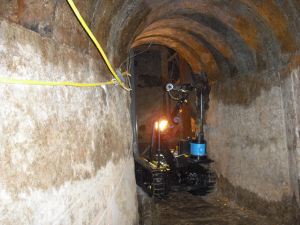Border securityThe challenges of detecting drug tunnels
As the United States has stepped up its efforts to secure its southern border, drug cartels have been forced to become increasingly ingenious in sneaking their cargo into the country; in an effort to avoid border agents, radars, and fences, cartels have increasingly gone underground

A tunnel mapping and scouting robot on the job // Source: clawar.net
As the United States has stepped up its efforts to secure its southern border, drug cartels have been forced to become increasingly ingenious in sneaking their cargo into the country.
In an effort to avoid border agents, radars, and fences, cartels have increasingly gone underground. Since 1990 border agents have discovered more than 150 tunnels below the U.S.-Mexico border, primarily linking San Diego to Tijuana.
In the past month alone, border officials discovered two major tunnels, one in San Diego which led to the seizure of seventeen tons of Marijuana and one in Nogales, Arizona.
More troublingly, the problem of tunneling seems to be growing worse. The discovery in Nogales made for the twelfth tunnel found this year and more than seventy have been found in San Diego since 2008.
Since their initial discovery, tunnels have become increasingly sophisticated with some outfitted with electricity, ventilation, and rail systems.
To combat this growing problem, DHS and the Defense Department have increasingly invested in technology designed to detect these underground passageways.
In one project, researchers are experimenting with ground sensors that use seismic waves to detect movement underground, while another uses robots to map the terrain using infrared and other technologies.
Tunnel detecting technology is severely limited by the ground itself. Ground penetrating radar does not pierce beyond forty-feet, and some tunnels have been discovered nearly 100 feet below ground. In addition, ground radar readings are hampered by several factors including urban settings and damp, clay-rich soils. Meanwhile other technologies like microgravity sensors, which measure small changes in the Earth’s gravitational field caused by cavities in the ground, are expensive and result in too many false alarms.
Given that tunnel detecting technology is costly and unreliable, many have advocated for bolstering police work and intelligence gathering efforts instead. More importantly, the majority of tunnels have been discovered with traditional police work rather than technology.
Elyssa Pachico, in In Sight, argues, “Considering that U.S. Border Patrol has defined only 15 percent of the southwest border as strongly secured, it’s unlikely the U.S. will develop anything close to control of the underground frontier anytime soon.”
“Resources may be better invested in areas like the cultivation of informants or supporting the investigative work of units like the San Diego Tunnel Task Force,” she writes.
